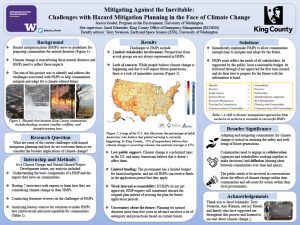Mitigating the Inevitable: Challenges with Hazard Mitigation Planning in the Face of Climate Change
It is without a doubt that climate change has and will continue to have adverse effects on the environment and future generations. We have run out of time to simply react to climate change and its associated natural hazards, and instead, we must become proactive and act quickly to mitigate and adapt communities for a future with increased risk. The purpose of my research was to understand some of the challenges associated with hazard mitigation planning and how we can address those obstacles while considering the implications of climate change. I discovered that Hazard Mitigation experts deliberately incorporate or avoid specific approaches, methods, wording, and information when writing their hazard mitigation plans (HMP) to increase their likelihood of being approved, receiving funding, and ultimately having a positive impact on the community of interest. However, it is crucial that our HMPs reflect the climate crisis at large and address the current needs of our communities while considering the impacts of exacerbated natural disasters. Regardless of how much we prepare for the future, climate change will indefinitely impact Washingtonians in all aspects of their lives with exponentially increasing frequency and intensity. Life as we know it will look very different in the following decades and will be laden with even more environmental challenges. In order to reduce some of the most negative impacts of climate change, we need to start implementing quality HMPs into communities in the present so that they have a shot at the inevitable future.
